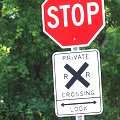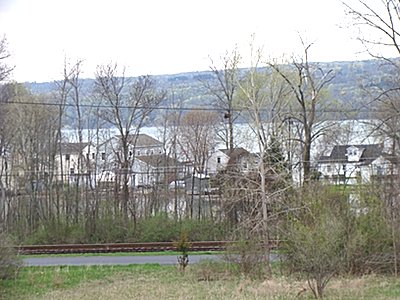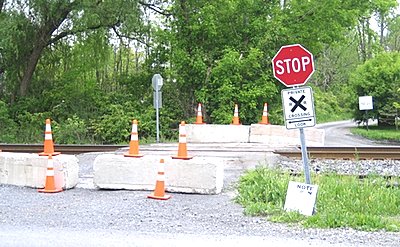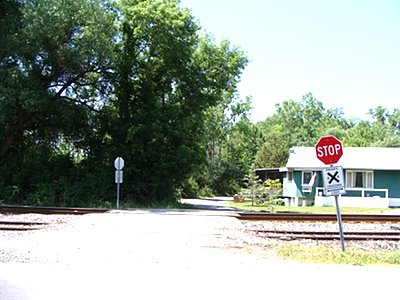- By Dan Veaner
- Around Town
 Print
Print  In 2008 the Norfolk Southern Railroad closed a private railroad crossing leading into Ladoga Park. Residents rallied to get the crossing reopened, siting deed easements and safety issues, and getting town, fire district, and state officials to support their plea. When that didn't work they took the railroad to court to try to force the crossing to be reopened. A week ago Thursday the crossing was reopened.
In 2008 the Norfolk Southern Railroad closed a private railroad crossing leading into Ladoga Park. Residents rallied to get the crossing reopened, siting deed easements and safety issues, and getting town, fire district, and state officials to support their plea. When that didn't work they took the railroad to court to try to force the crossing to be reopened. A week ago Thursday the crossing was reopened."Ironically the barriers were removed almost exactly a year after we won at the Appellate Division with respect to the prescriptive easement," resident Noel Desch says. "The Appellate Division was going to require it to go to trial with respect to both the deed access and the prescriptive easement. That's what we were preparing to do."
It worked. Ten days ago a settlement was reached. Two days later the crossing was reopened.
"The railroad in sincerity felt that the policy of closing private crossings wherever they could would enhance the public safety," explains Desch. "However they really didn't look at it carefully because the record for that crossing has no accidents throughout its history. The sight distance is excellence in both directions and by imposing that closing they limited Ladoga Park to one direct access, the public crossing where the signals now are. With subdivision requirements these days you are pretty much required to have two access points, which we no longer had."
 Ladoga Park is bordered by the lake on one side and is cut off from the mainland by a railroad track.
Ladoga Park is bordered by the lake on one side and is cut off from the mainland by a railroad track.Ladoga park is a small lakeside neighborhood with about 25 homes, about half of them used by year-round residents. It is a beautiful neighborhood when it's not flooded, a recurring scourge for residents there. Ladoga Park Road is a ring road, connecting at both ends with Lake Shore Road. The eastern-most entry has a regular railroad crossing with flashing lights and a bar that lowers when a train is coming. The western entrance is a private crossing that was closed with concrete barriers three years ago.
Desch says that modern code for new developments requires two access roads, so closing the private crossing posed a safety hazard. While the railroad owns a small access road from the entrance to Myers Park and marinas there, Desch says that large emergency vehicles could have a hard time entering that way, especially in winter. The private crossing offers a straight shot for large emergency vehicles.
 Three years ago these barriers were erected by Norfolk Southern Railroad.
Three years ago these barriers were erected by Norfolk Southern Railroad.When the crossing was first closed residents lobbied the railroad to reopen it. They presented letters from town and fire district officials in support of opening the crossing, and NYS Senator Mike Nozzolio toured the area, then wrote his own letter citing safety concerns if the crossing remained closed. When those efforts failed, residents resorted to the courts.
"The railroad claimed that the marina crossing was sufficient, but the fact of the matter is that crossing is congested with traffic in and out of the park quite frequently and would delay emergency vehicles coming to the end where the closed crossing was," Desch says.
Cornell law professor Eduardo Penalver offered his pro-bono services to research the problem and represent the neighborhood against the railroad. His law students acted as historians, proving the crossing was open for use as early as 1879. Attorney James Salk represented the residents in appellate court.
"It went through the Supreme Court with Judge Robert C. Mulvey, and then the Appellate Division in Binghamton," Desch explains. "Mulvey turned us down. He turned down the safety issue, and the easement and the deed. So we appealed. Once we appealed and were preparing to go to trial someone at the railroad decided that was excessive, so we didn't need to do that."
Even though Penalver did not charge for his services, residents ended up paying more than $3,000 to get back something they had always had. Desch and his wife Janet were among five plaintiffs in the suit against the railroad, chosen by their attorney as a representative cross section of the neighborhood, but with the understanding that all residents would benefit if the case were successful.
"If we did end up going to trial it would have ended up being much more expensive," says Desch. "Pretty much everybody in the whole neighborhood contributed, with only a couple of exceptions."
The agreement allows for the opening of the crossing with some conditions. The residents will maintain it and hold the railroad harmless in case of an accident. The railroad will hold the residents harmless in case of an accident. The agreement does not limit the use of the crossing to the plaintiffs. The public has access. The only burden on the plaintiffs is the provision to hold the railroad harmless if anyone in the plaintiff's family is injured or killed at the crossing, and the railroad holds residents harmless as well, except when an incident is the result of a deliberate act. It specified that the railroad had 60 days from the time of signing to reopen the crossing. The settlement was signed on July 5th. Two days later the barriers were removed.
 Just over a week ago the crossing was reopened.
Just over a week ago the crossing was reopened."Everybody in Ladoga Park is very pleased with the railroad," Desch says. "Instead of waiting until the 59th day they removed it now. Particularly with it being summer with more activity, that was a big help."
While residents are very happy with the outcome, they feel that the time and legal expenses could have been avoided for both sides if Norfolk Southern had been more open to talks from the beginning. Desch notes that the Railroad spent a lot more on the case than his neighbors did.
"The question we will never have an answer to is, why didn't the railroad offer this before they closed the crossing?" he says. "Because it's a pretty straightforward settlement."
Residents lost no time in clearing the crossing, widening it for better access. Desch says more work will go on there to make it wide enough that large fire trucks will be able to pass through in any weather. Residents will maintain it, including snow plowing, something they do anyway because Ladoga Park Road is a private roadway. And at last they feel less cut off, especially in cases of emergency.
v7i27



